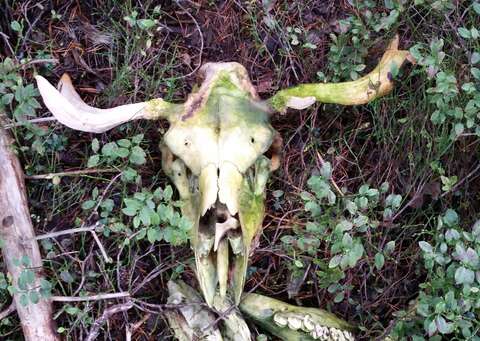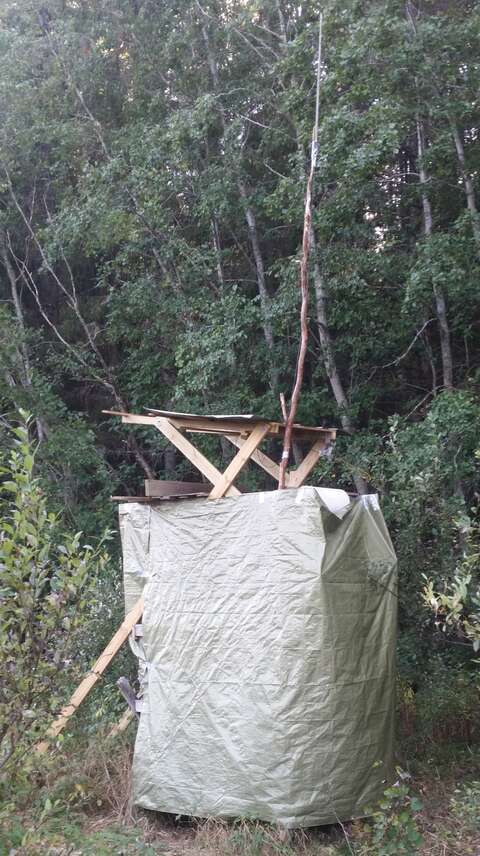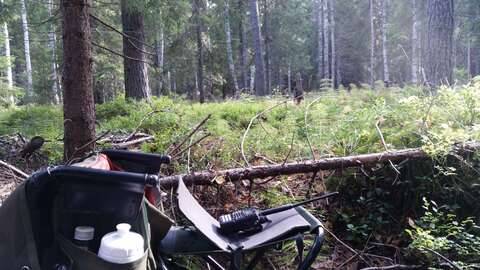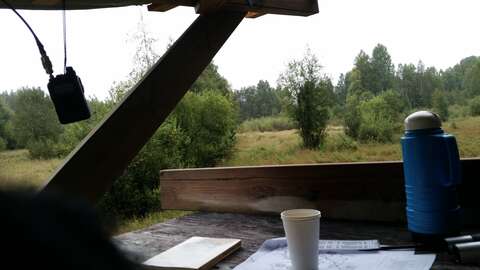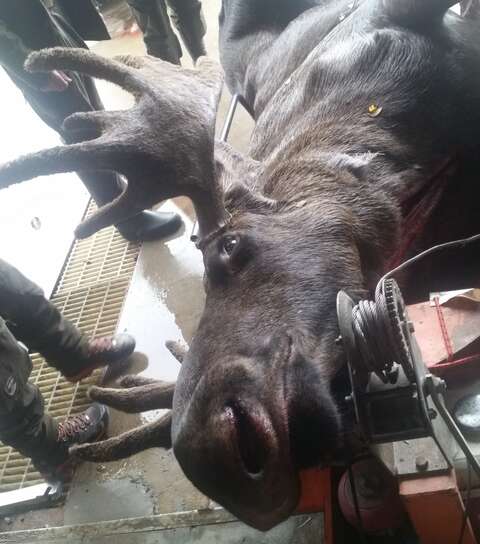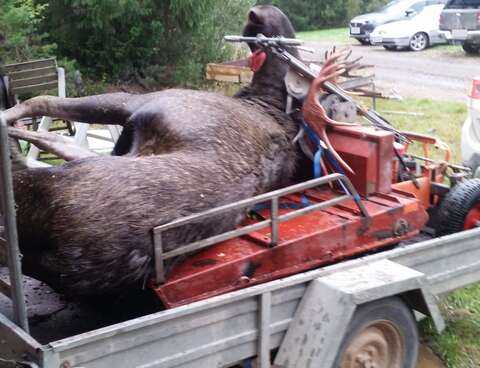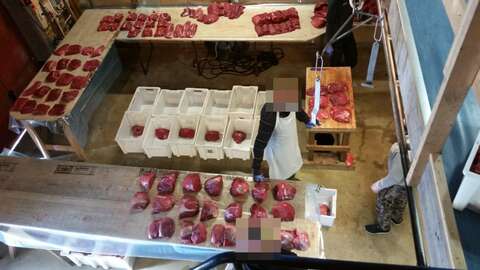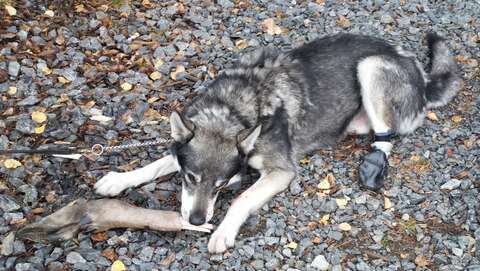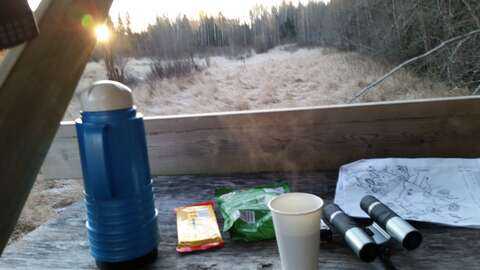Last year I participated in my first ever moose hunt. This post documents my experience of it. Being a huge nerd I have also collected some statistics around it as a labour process.
For readers who are unaware, the moose hunt in Sweden is something nearly religious. Life in rural Sweden largely revolves around it, and the year for many is divided into before, during and after the hunt. Entire sections of Swedish society shuts down, especially during its first weekend. For example the surgery ward in Sundsvall shut down a couple of years ago because all the surgeons were out hunting.
Oh and a warning to sensitive readers: there will be dead animals, but I'll keep the bloodiest parts out.
Background
I have a summer house since a couple of years back. Because it is outside city limits (detaljplanerat område), this both entitles and obliges me to take care of the large game on it (viltvård). Up here that means moose and bears. To this end I signed an emphyteusis contract (arrende) with a local hunting team a while back, letting them take care of it for me, which is a standard arrangement up here.
In late 2022 I noticed ABF (the Workers' Educational Association) was holding a hunting course here in Umeå. I'd already gotten more curious about flora, having done calculations around and attending seminars on sustainable logging, and also writing about BECCS here on the blog (GoBiGas technical coefficients). Given that, but not having a good grasp on fauna and also holding hunting land, this struck me as an excellent thing to enroll in. Also shooting is fun. I enrolled around November 2022, and by May 2023 I had passed the theory exam. In Sweden hunting theory covers a lot, and the exam is particularly difficult. 60 out of 70 questions must be answered correctly. As soon as the snow cleared the shooting exam was also swiftly taken care of - turns out I'm a decent shot!
During all this I got in contact with the leader of the hunting team, who was happy to accept a new (trial) member.
How moose hunting works
Most moose hunting in Sweden works like this: an area is chosen, typically many hundreds of hectares in size. Stationary shooters are positioned around the area, either in stands or on the ground.
Above left is a picture of the stand on my property. It's outfitted with an antenna for better radio coverage, and padding on the seat for maximum comfort. The tarp makes it moderately wind proof. The picture on the right is another spot, a shallow pit in the ground.
Once the shooters are in position, dog teams are sent in to locate and to try and get the moose moving towards the shooters. The dog teams often have shooters of their own, who tend to fell the plurality of animals. VHF radios are used to coordinate things. The dogs and their handlers typically have GPS trackers and associeted phone apps, which sadly are proprietary software.
Once felled, the animal is field dressed and a "moose puller" (combitrac, a kind of tracked sled) is used to pull the animal out of the woods onto a trailer. The animal can then be taken to a slaughtering hut and processed further. Animals typically aren't quartered in the field, which I hear is the norm in North America.
Preparations
Preparations included one half day of maintenance with the entire team splitting up into groups and fixing the hunting stands among other things. I was assigned to the cleaning crew this year, so another half day of cleaning the butchering tools was also done. Not too laborious.
The first weekend
I already had the notion that the first hunting weekend is quite hectic. It turned out to be even moreso than I had anticipated. The hunt started on Friday the 1st of September. "In position at 06:00" meant waking up at 05:00. Luckily I was assigned to the stand on my property, so I did not have to do much more than make breakfast, brew coffee, pack sandwiches and walk with my gear to the stand. Subsequent days I would pre-load the coffee maker and make sandwiches the evening before.
Getting into position means climbing into the stand, unpacking the map, radio, coffee and snacks, as well as loading and safing the rifle. For those wondering: a Carl-Gustaf ("Swedish Mauser") in 6.5x55 mm Swedish. Then begins the main task: waiting. Waiting and listening and watching.
One unfortunate thing during this very first "shift" is that I had the wrong frequency programmed on my radio. Apparently there was a bull moose very close to my position, but I was not able to hear the heads-up over the radio, and the sneaky mister evaded my senses.
At around 11:00 there was a break. One bull and one calf down. Meetup at the butchering hut. The calf had already been processed when I got there, and since recovering the bull was taking some time, most people present ate lunch.
When he arrived, the bull was winched by the hind legs and hung by the equivalent of the gaskins on a horse. The main task was to flay, gut and quarter the field dressed carcass. Being new, I observed the flaying. Noticing my interest, I was instructed by a team member how to do it, and joined in. Once enough of the hide had been liberated, the winch and two metal "claws" were used to grip the hide and pull the rest of it off like a sweater. The head and hide were removed and the hide salted for sale to tanners. The remaining guts were removed and a reciprocating saw was used to cut the carcass in half along the spine, which is about as nasty as it sounds. Each half was then hung on hooks and halved again into front and hind quarters. The quarters were further processed and finally put into a walk-in fridge to hang until Thursday. This is important for tenderness. All in all the process described above took maybe 1-1½ hours.
After this some Cameroonian forest guest workers showed up to pick through the bits destined for the offal tip. The priest in our team assisted in extracting the tongues and cheeks from the moose heads, which our guests happily accepted. I am not sure what organs they took, but next year I'll be sure to warn against taking livers from adult animals due to risk of fallout from Chernobyl, and other toxins that tend to accumulate in old livers. Later on I took a calf liver for myself, and next year I'll probably snag a tongue.
Around 13:00 everyone headed out into the field again. My radio was correctly programmed this time. A second bull was felled and we headed back to the hut around 17:00.
This bull too was processed. After this we in the cleaning crew still had cleaning to do. When everything was said and done the time was 19:30. Twenty people had been going at it for thirteen and a half hours. I went home, ate dinner, prepared sandwiches for the next day and promptly collapsed in bed. No shower because my water heater decided this was a good time to break.
The second day was similar to the first day, but luckily ended around 18:00. Two bulls felled. The third day ended up a half day. One heifer, one bull. The walk-in fridge was now full and all that remained was to wait until Thursday. On Monday I borrowed my neighbors' shower and washed off three days' worth of stink. Celebratory beers were had.
Butchering
The meat that makes up each team member's lot was processed the Thursday after the hunt. 5-6 people took care of separating the large pieces into cuts. The rest, me included, were on polishing duty for the pieces that were going to be turned into mince. This involves cutting away excess fat and connective tissue.
All in all everyone got around 25 kg of cuts and a bit over 13 kg of mince. I heard the number 800 kg in total. What I had not planned for was that I had to further cut the pieces up for freezing. For some reason I had assumed everyone would be getting portion pieces vacuum sealed or something. Not so! So in addition to six hours of butchering, the rest of the evening was spent splitting the cuts into portions and similarly with the mince, labelling and finally putting everything into my freezers. By 23:00 or so I was finished.
Subsequent weekends
The weekends after the first one were far less taxing, and there is less expectations on attending. Attending means getting points towards half calves, which are handed out in a round robin fashion to those who have attended ten shifts. Any adults felled on subsequent weekends were sold flayed and quartered to a butcher, bringing money into the team.
Above is one of our dogs enjoying a cut-off foreleg. He'd lost one of his claws in the woods and so was out of commission for the rest of the hunt.
September 23rd was the end of the first part of the hunt. Eight days hunting plus one day butchering up to this point. Everyone enjoyed a two week break before resuming.
My notes on the October hunt are sparse, but it involved two weekends before weather caused another pause. This because morning frost would risk hurting our dogs' pawsies. Eventually it got cold enough that I had to use a kerosene stove to keep warm in the field.
Another attempt was made on November 3rd after sufficient (but not too much!) snow had fallen. I was not able to attend, and turnout was only seven people. No animals felled.
A final attempt was made on the 25th of November on skis, which I was also not able to attend. Based on the lack of any SMS to the contrary, I assume no animals were felled here either, especially since dogs were not an options.
Closing thoughts
I've learned a lot from all this. Much like getting my amateur radio license has lead me to notice antennas everywhere, getting a hunting license means I take note of wild animals much more than I used to. Reproduction cycles, migratory patterns, what kind of fowl lives in the area, tracks in the ground..
Because I do not eat much meat, I now have more of it than I suspect I'll be able to eat in a year. But that is less of a problem as I have plenty of friends who are interested in buying meat from me. I also tend to bring moose meat to dinners with friends or family, which has so far been greatly appreciated!
I did not see any moose at all during the hunt, but it was close several times. Therefore I did not fell any moose yet. Time will tell whether I have it in me to kill.
I have plenty of friends who are vegetarian or even vegan. The reactions from them have so far been mixed, ranging from "you are psychopathic!" to "well, someone has to do it". The former camp are usually not willing to discuss game politics, nor confront whether it is better for the game that death comes as a surprise, or if it is better that they are taken by wolves or bears where death comes.. not as a surprise. There is also the issue that while predators don't really attack people, they do attack dogs, horses and livestock. And they of course compete for game. Without predation or hunting, the moose and deer population would explode, causing problems for forestry, agriculture and causing even more traffic accidents.
Another factor is the logging companies, who would prefer that the moose were eradicated. This because moose love grazing on young spruce and pine, which hurts profits. Such excessive culling is not popular with the hunting corps, nor with conservationists. One example in the news is the Finnish forest company Stora Enso telling the hunters on a section of their land to fell 152 animals rather than the 52 allotted by the authorities (Jägareförbundet rasar mot Stora Enso inför älgjakten: ”En absurd historia”). This has led to some hunters in the area boycotting the hunt (Jägareförbundet i Dalarna uppmanar till bojkott av fortsatt älgjakt). Despite this 74 animals were still felled, and the authorities appear to be powerless to do anything (Fler älgar än beslutat fällda runt Hällefors – länsstyrelsen i Örebro försökte avbryta jakten).
Numbers
The numbers below are counted on the team as a whole, 19 people. We had one guest during the first weekend, making 20 in total unless I missed some. The area covered is 4000 hectares.
Preparations: 92 hours
First weekend: 590 hours (lunches subtracted)
Butchering: 118 hours
Subsequent weekends: 747½ hours
Yield: about 800 kg of meat (cuts and mince) plus bones
Time per kg of meat: 1h56min
Call it an even two hours per kg. This does not include the time people spend the rest of the year putting up salt licks, putting out winter feed, tending to camera traps and so on.
There are many tools that could greatly reduce the hours listed above, such as drones and thermal cameras. Such tools are currently illegal when hunting moose. Initially I thought these rules silly, but having realized that the logging companies would love it if they could use drones with thermal cameras to kill all moose on their land, perhaps these rules aren't so bad.
If land was held in common and if the profit motive was not front and center, the situation would be very different. Much larger hunting teams might be formed, benefitting from economics of scale; the area covered by stationary shooters is quadratic in the number of shooters. Fewer moose would slip past as they do at present, and the limiting factor would be dogs. Some readers might think "well why don't you just do that now then?", but the problem is the logging companies that own vast tracts of land up here in Norrland. It is very difficult to form large patches of nicely shaped land (välarronderad mark) that doesn't include too much land owned by these companies. As a result, teams become smaller and hunting labour-power is used inefficiently. Private property puts fetters on this aspect of production, just like all others.
